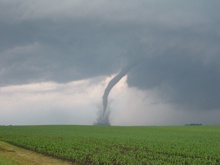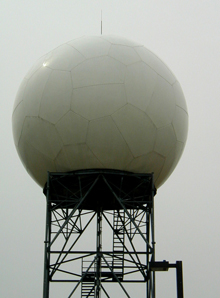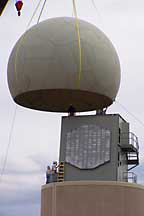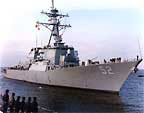New Radar Technology Can Increase Tornado Warning Lead Times: Navy's Phased Array Radar Being Adapted for Weather Use
NOAA’s National Severe Storms Laboratory develops and tests new radar technologies essential to providing integrated observations, predictions, and warnings of high-impact weather such as tornadoes, severe thunderstorms, and flash floods.
- Introduction
- Research and Development
- History of Phased Array Radar
- Promising New Radar Technology
- Partnerships for the Future

Tornadoes can occur anywhere and at any time of the year. Peak tornado season in the southern states is in March through May, while peak months in the northern states are during the summer. Tornadoes are most likely to occur between 3 and 9 p.m., but can happen all hours of the day or night.
Tornadoes are one of nature's most violent storms. In an average year, about 1,000 tornadoes are reported across the United States, resulting in 80 deaths and more than 1,500 injuries.
While technology has greatly enhanced the ability of NOAA’s National Weather Service to provide advance notice of approaching severe weather such as tornadoes, researchers are always looking for ways to do their jobs better. A new technology, phased array radar, is being tested at NOAA’s National Severe Storms Laboratory (NSSL) in Norman, Oklahoma. This new technology may help forecasters of the future provide earlier warnings for tornadoes and other types of severe and hazardous weather.
A Leader in Weather Radar Research and Development

A NEXRAD Doppler radar tower is a common sight around National Weather Service Forecast Offices. The radar was the backbone of the National Weather Service modernization that was completed in 2000. Click image for larger view.
Norman is already known as a national center for weather radar research and development. NSSL's research in Doppler radar led to one of the most successful and significant technology advancements since the launching of the first weather satellite.
Nearly 30 years ago, NSSL was a major participant in the development of Doppler technology that eventually became the heart of the WSR-88D (Weather Surveillance Radar–1988 Doppler) radar, or NEXRAD (NEXt generation weather RADar). The deployment of a system of 120 NEXRAD radars across the United States was the cornerstone of the modernization of the National Weather Service.
The phased array radar project has begun a new stage in NSSL's leadership in the research and development of future generations of weather radar.
History of Phased Array Radar

Researchers are adapting the SPY-1 radar technology, developed by Lockheed Martin to support tactical operations aboard Navy ships, to weather detection. Here, a SPY-1A antenna and radome are being installed on the National Weather Radar Testbed.
Some U.S. Navy ships use AEGIS phased array radar (called SPY-1) technology to protect naval battle groups from missile threats. Researchers believe this same technology has great potential for increasing lead-time for tornado warnings.
In 2000, the U.S. Navy agreed to loan a phased array antenna to NSSL. NOAA, the Navy, adn other partners provided the funding and equipment to help build the National Weather Radar Testbed. The National Weather Radar Testbed is a facility focused on developing faster and more accurate warning, analysis, and forecast techniques for severe and hazardous weather using phased array and on investigating multi-mission aspects such as wind profiling and aircraft tracking.
The National Weather Radar Testbed became operational in September 2003 and the first data were collected in May 2004. Additional data sets were collected during the 2005, 2006, and 2007 storm seasons.
The National Weather Radar Testbed allows NSSL and project partners to determine if this radar technology, that has been used by the military since the mid-1970s but not been applied to weather detection, will become the next significant technology advancement to improve our nation's weather services.
Promising New Radar Technology
Early tests of the phased array radar system show that the technology has the potential to vastly improve upon the capabilities of the national NEXRAD radar network for all weather radar applications. Current WSR-88D radars transmit one beam of energy at a time and listen for the returned energy while rotating the antenna at a given elevation angle. The radar then mechanically tilts up to a higher elevation angle and samples other sections of the atmosphere while rotating the antenna 360 degrees. When the radar has sampled the entire volume of atmosphere, from bottom to top, the process starts over again to collect another volume of data. A volume scan of desired portions of the atmosphere takes around four to six minutes, depending on the Volume Coverage Pattern selected.

Phased array radar’s rapid scanning ability gives it the potential to be a multi-mission, adaptively scanning radar, meaning it is used for weather, wind profiling, and aircraft tracking and can adaptively change its scans to look at the most important features. Click image for larger view.
A four-faced phased array system, on the other hand, can use multiple beams and never needs to tilt or rotate the antenna. The beams of energy are steered electronically and thus the radar has no moving parts. Using multiple beams and frequencies, phased array radar reduces the scan time of weather from four or five minutes for NEXRAD radar to less than one minute. This allows faster updates of weather data.
In addition to faster updates, the new system can re-scan areas of severe weather very quickly, potentially increasing forecasters' warning lead times as storms rapidly transition to severe modes. This technology has the potential to increase the average lead time for tornado warnings well beyond the current average of 13 minutes. Other technology being developed at NSSL will extend lead times even farther.
The new technology will gather storm information not currently available, such as rapid changes in wind fields, to provide a more thorough understanding of storm evolution. Researchers and forecasters can then use that knowledge to improve conceptual storm and storm-scale computer models. The data will also be used to initialize computer models and improve forecasts. Phased array technology will increase fundamental understanding of storm evolution, in turn leading to improved computer models, more accurate forecasts, and earlier warnings.
Partnerships for the Future

Phased array radar is currently used on Navy ships to support tactical operations.
The phased array radar technology is being developed through a unique federal, private, state, and academic partnership. Participants include NOAA's National Severe Storms Laboratory and National Weather Service Radar Operations Center, Lockheed Martin, the U.S. Navy, the University of Oklahoma, the Oklahoma State Regents for Higher Education, the Federal Aviation Administration, and Basic Commerce and Industries.
The project – from research and development to technology transfer and deployment throughout the U.S. – is expected to take 10 to 15 years, at an initial cost of approximately $25 million for the facility in Norman.
Contributed by Keli Tarp, NOAA’s Office of Communications
